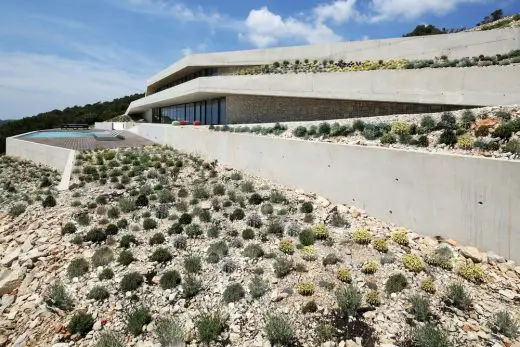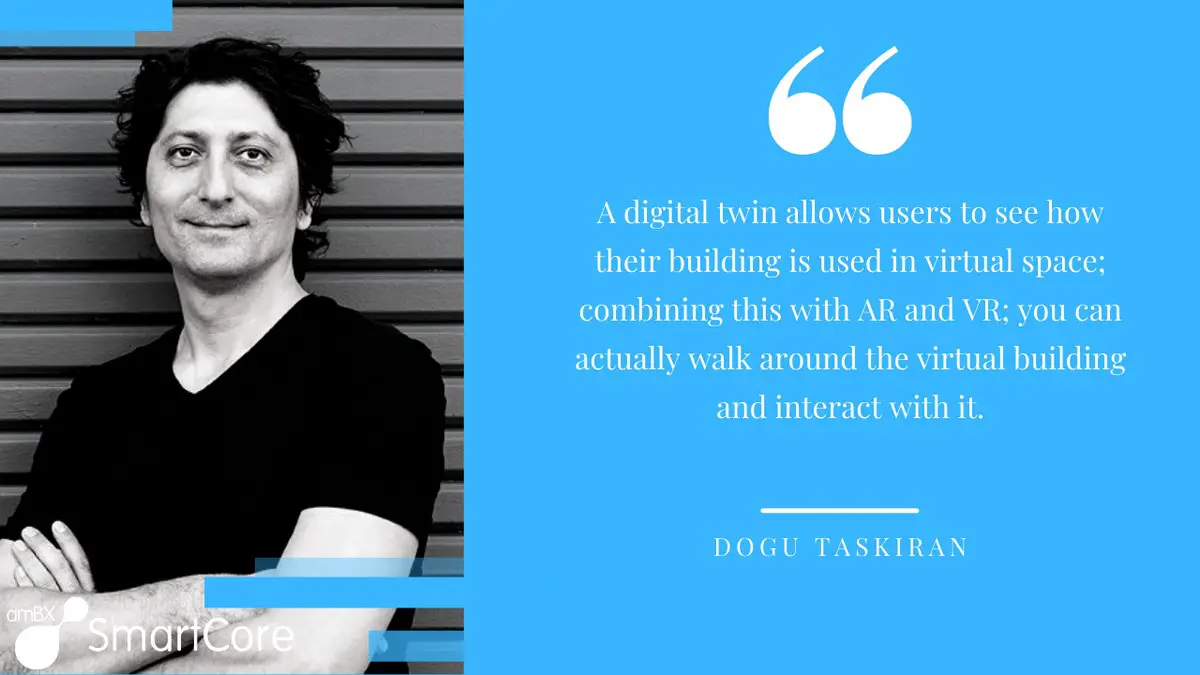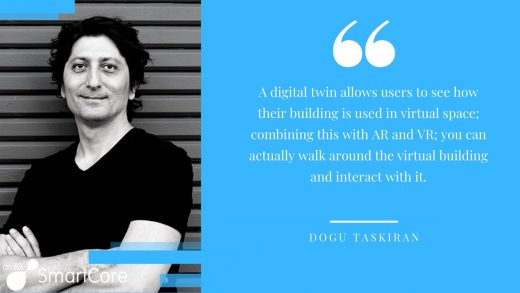Digital Twins and Smart Buildings guide, Future building construction, Online amBX SmartCore software advice
Digital Twins and Smart Buildings News
9 Sep 2021
amBX Interview Dogu Taskiran on Digital Twins and Smart Buildings
9th of September, 2021 – Smart lighting and building software expert, amBX interviewed Dogu Taskiran, a software developer, a smart city thought leader and the CEO of Stambol Studios, based in Canada. He has previously worked for Microsoft and has shared his thoughts on digital twins, how they work, the benefits and how they can make a building or even a city smart. The global digital twin market size was valued at USD 3.1 billion in 2020 and is projected to reach USD 48.2 billion by 2026. It is expected to grow at a CAGR of 58% during the forecast period.
Digital Twins create virtual replicas
The potential for growth and development is outstanding – amBX SmartCore software uses a digital twin to create a virtual replica of each space within a building. This enables rapid setup and re-configuration of building and lighting systems, real-time data can be capture and analysed and changes can be made instantly.
Firstly, Dogu states that there are many definitions of a digital twin, but the actual source definition was created by Michael Greaves, at the University of Michigan in 2003, in a course on product lifecycle management. He described it as a virtual digital equivalent to a physical product. There are three main prerequisites for something to have a digital twin. It’s a physical product in real space, a virtual product in virtual space, and the interconnectivity of data and information to tie these two things together.
Digital Twins create control
A digital twin can tell the user how their building is used, and the current ‘state’ of it- it can show whether a specific door is open or closed but taking that one step further and integrating it with virtual and augmented reality, the user can actually see if the door is open in the virtual model and walk around the building. The digital twin can be used to control physical assets or gather information and simulate changes, predicting what will happen in the future. Historical data collected from the digital twin allows anomalies to be highlighted. This, therefore, facilitates predictive maintenance, extending the life of assets, or improving operational efficiencies.
In addition, this can be done automatically; AI can make decisions. It can decide to turn the AC on in a certain area and the lights off in another.
A main question a lot of people have, is how do Digital Twins Link into Construction 4.0. Construction 4.0 is referred to as the fourth industrial revolution. Construction is one of the latest industries to adopt technology; it’s basically one level above agriculture.
BIM is an interesting concept. Dogu observes BIM as being the main driver up until the construction and handoff of a building. It starts with the design concept, and then that is turned into constructible plans. At that point, it is still a static model. That means the BIM model lives up until the handoff stage, and then its life ends.
Merging BIM with a digital twin presents the opportunity to extend its lifecycle from concept all the way to the end of life of the building. Integration with IoT devices, machine learning and all the other assets that enable users to visualise context. Storing and gathering data about every asset makes predictive analytics and operational excellence easier to achieve. It will allow adverse environmental effects to be anticipated; maintenance can be forecast and carried out much earlier to avoid breakdowns or inefficient running.
For example, if a boiler in a shopping mall is going to break down in the next couple of weeks, the Facility Manager will know because of the sensor data being analysed by AI and machine learning. They will know who maintained it last, the warranty, maintenance records etc. It will act as a single source of truth—a common database for everything that happens within the lifecycle of the building. In addition, this can all be monitored remotely by the Facility Manager.
However, there are factors hindering Mass Adoption. Dogu considers that standardisation is essential. Creating open, interoperable protocols so that technologies don’t just evolve by themselves; no company will achieve full smart buildings and cities by themselves. The industry needs standards to create a unified approach. Any device/system should then be able to integrate and provide or receive information.
On a larger scale, a digital twin can benefit urban planning because it allows planners to predict what would happen if a building was constructed in a particular area, e.g., how long does traffic need to be blocked for? What will the new pedestrian flow be? All these simulations can take place before construction even happens.
Some cities are visionary, they have taken the BIM model from every architect in the city and created a virtual replica of it. Singapore is a city that has led this innovation; they even gave sensors to their citizens so that they could understand the pedestrian pathways and how they’re utilising the city. This allows necessary changes to be made at the planning stage, which in turn reduces carbon emissions.
The benefit to a normal person walking down the street is that it adds a lot of advantages from a safety point of view, having streetlights that turn on because they sense that you’re there, reducing crime rates because more is monitored etc. Or even benefits such as the traffic lights only turning red when there is a need, improving your journey, reducing commuting times and working in your favour, or letting emergency vehicles through, showing a pathway with the streetlights.
This becomes a trade-off; people are less reluctant to be monitored and have data captured about them if it benefits them. It’s when it’s not working in their favour that the issues arise. It’s going to be important that people are aware of what the data is for, how it is collected, what’s going to be done with it and how it will be stored. That transparency will go a long way.
Vision of the future of smart cities
amBX asked Dogu about his vision of the future of smart cities. He summarises lots of things can come out of this, but today, we have virtual/augmented reality and mixed reality and we’ve got conversational interfaces (Alexa, OK Google, etc.). The best technology is invisible; you don’t even notice that it is there. Such as walking into a room and it knowing that a person prefers a certain temperature and as such the AC temperature is adjusted to that level – whilst it is a benefit, it isn’t apparent until there is an issue.
Dogu comments, “My vision for the future city is that we have a digital replica that allows us to collect analytics, meaningful data, helps us make much more meaningful decisions, derive better insights and visualise that in context. That’s going to happen in the next 5-10 years, but in 20 years, that’s a bit of a hard guess; I think it will start with ambient immersive user experiences that automatically do everything for the occupant. However, as with a lot of these things, you have no idea you need them or that they exist until the moment they actually do.”
To listen to the full podcast, go to https://anchor.fm/ambx/episodes/Ep–12-Digital-Twins-in-Smart-Buildings-and-Cities-e15f34p. For more information on amBX and its services, contact amBX.
Comments on this guide to Digital Twins and Smart Buildings article are welcome.
January 18, 2022
Cityzenith Digital Twin for Las Vegas
Cityzenith’s ambitious project to help Las Vegas building owners transition to net-zero carbon emissions using its SmartWorld Digital Twin technology has completed its first phase.
Cityzenith Digital Twin for Las Vegas
Building Articles
Residential Architecture
Issa Megaron, Vis island, Croatia
Architects: Proarh

photography: Miljenko Bernfest and Damir Fabijanic
New House on Vis island Croatia
Comments / photos for the Digital Twins and Smart Buildings page welcome






